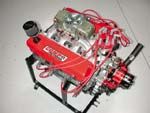
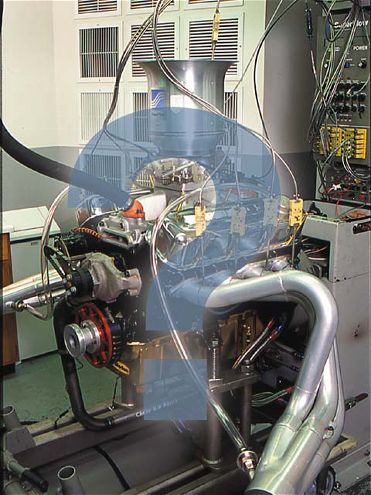
The difference between engine-building professionals and us regular guys is the pros can spot trends on the dyno or at the track that combined with their experience provide clues to the developmental path for improving an engine's performance. What are some of these clues and indicators, and how does one use them to figure out if he has the "right" cam?
"Right" is of course subjective and will vary per application. For example, engine vacuum is unimportant for race cars, yet is critical for most street cars with power brakes or emissions equipment. Race cars aren't octane limited; street cars must run (at best) 94-octane gas. All this impacts your cam choice. Dyno developers like to look at the torque and horsepower peaks. They select cams based on where they want those peaks to occur. As Crane Cams' Allen Bechtloff puts it, "Use the dyno to move the torque curve around. The right horsepower and torque at the right place is more important than the peak." The "right place" correlates with the engine's intended use, the vehicle the engine will go in, and the other parts in the engine. If cylinder-head flow stalls at 7,000 rpm, it makes no sense to run a cam that makes peak power at 7,200.
Careful analysis of volumetric efficiency (VE), Brake Specific Fuel Consumption (BSFC: a measure of how many pounds of fuel an engine needs to make one horsepower for one hour), and airflow (cfm) can tell an experienced engine tester a lot about a combination. Peak torque, peak VE, maximum cylinder pressure, and the lowest BSFC should all occur around the same rpm. According to Kevin McClelland, head of dyno research and development at Flowmaster Mufflers, "VE should occur within 500 rpm of the torque peak. If max VE is 1,000 rpm above the peak, the cam's too big for the rest of the combination."
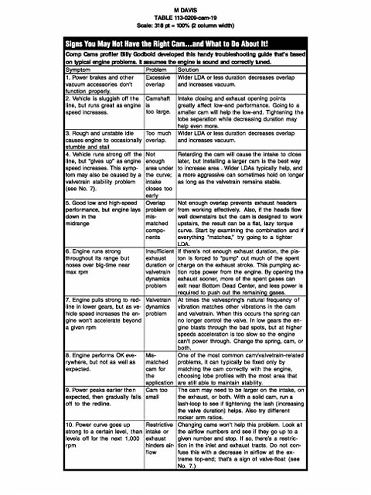
Yet it's a truism that "dynos don't win races." The best cam on the dyno may not perform best in a real car. A short-oval-track engine might be set up with a cam for more torque to come out of the corners. But at some point in the development process, the engine gets too good, making so much torque the car won't hook up. At this point you might want to shift the power curve to a higher rpm, giving up some low-end torque on corner exit and adding more power to tear up the straights.
Whether on the dyno or in the car, you can get a pretty good feeling of whether the existing combo is sound by retarding or advancing the cam. Retarding the cam tends to make more horsepower. Advancing the cam tends to make more torque. Most aftermarket catalog grinds are already ground 4 degrees advanced over the straight up, "split-centerline" position. Judson Massingill runs the School of Automotive Machinists (SAM), training the next generation of performance engine builders. He says if the engine picks up when the cam is advanced another 2 degrees (for a total of 6 degrees advanced over split-overlap), you need to put a smaller cam in the motor--about 5 degrees less duration at 0.050. If you retard the cam to split-overlap and the engine picks up, a larger cam 4 degrees advanced from split-overlap will run better. "The intake closing point is by far the most important of four cam phasing points. A slightly larger cam installed 4 degrees advanced over split-centerline tends to close at about the same point as a bigger cam installed at split-centerline." Trying different rocker arm ratios and (with a mechanical cam) varying the valve lash indicates whether the engine would be happier with a different cam. Another good tool is a simple compression test (see sidebars).
Old-timers such as Comp Cams' Scooter Brothers like to remove the headers and check exhaust port coloration. Sooty ports mean unburned fuel is being pulled into the ports, indicating the "overlap triangle" (the portion of the four-stroke combustion cycle during the transition between the exhaust and intake strokes when both the intake and exhaust valves are open) is too large or the overall cam phasing is too late. Ideally, Brothers says exhaust port coloration should have the grayish-white color of blackboard chalk. But remember, fuel additives often add a reddish tint.
Sometimes it's not the cam profile itself that's solely to blame for problems, but rather its interrelationship with other valvetrain components. Most of us are familiar with the term "valve float," a high-rpm condition where the valves remain open because the spring tension is insufficient for the lifter to follow the lobe. At some point, any engine goes into valve float; the goal is to delay its onset past the cam's useful operating range. This is usually accomplished by installing the recommended springs for the cam at the proper installed height. On the other hand, over-springing an engine can accelerate lobe wear and hydraulic lifter bleed-down rate.
When valve float occurs, it's easy to spot (see "Lash Loops" sidebar), but there are other mysterious gremlins lumped into the "valvetrain harmonics" category that bedevil even the best tuners. Research is still ongoing, and even today all the factors are not fully understood. As Crane Cam's Mark Campbell puts it, "Different cam lobes can tickle or stimulate the spring in different ways. You may have similar lobes, but due to the acceleration rate of the flanks or whatever, one spring may perform better on one lobe than on another. When you see dips in the power curve in the 4,600-6,000-rpm range, suspect a valvetrain problem--either a spring harmonic, or pushrod harmonics." This has implications for today's fully assembled aftermarket heads, as their generic springs--despite having pressures and an installed height that in theory are OK for a given cam type, lift, and duration--obviously can't be tested for every lobe profile.
All of this stuff was discovered through testing, testing, and more testing combined with experience and prior knowledge of similar combinations. With all these variables, the occasional engine builder would be wise sticking to proven combos. As Winston Cup consultant Chuck Jenckes puts it, "The average HOT ROD reader should follow the recipe. Read the magazine's engine buildup of an engine he wants to build and copy it exactly." Then you can blame us!
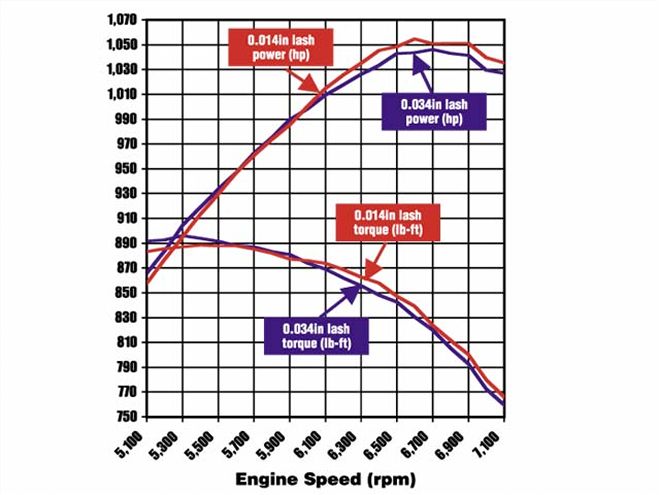 Tightening the lash on this DNE-built 525ci big-block Chevy made a little more power on top. For a race-only motor, this trend indicates the engine may like a slightly more radical cam.
Tightening the lash on this DNE-built 525ci big-block Chevy made a little more power on top. For a race-only motor, this trend indicates the engine may like a slightly more radical cam.
Lash Loops
Many experts feel that a good developmental tool is temporarily varying the valve lash on a mechanical cam from the manufacturer's baseline recommendation. Besides changing the valve lift, an 0.010-inch lash-change also alters duration at 0.050-inch tappet lift by about 4-6 degrees as measured at the valve. Typically lash is varied 0.005 inch at a time to see if the engine responds. Really hardcore builders run "lash loops" separately on the intake and exhaust sides for every cam they test.
If power goes up with more lash, the cam may have too much duration. If tightening the lash increases power, you need a bigger cam. If the cam makes its best power with the lash set per the manufacturer's recommendation, it's pretty close. Caution: Typical modern cam lobes won't hold up for long under large lash variations. Some "tight lash" grinds (cams with factory setting under 0.015 inch) don't like more than 0.005-inch lash changes.
On tests of a DNE Motorsports Development 525ci big-block Chevy equipped with a solid roller cam (270/280-degreed 0.050-inch tappet-lift duration, 0.750-inch-plus valve-lift, and a "secret" LDA), tightening the lash from 0.034-inch to 0.014-inch (the original baseline setting was 0.024 inch) was worth 8.5 hp, but cost 7.7 lb-ft of torque.
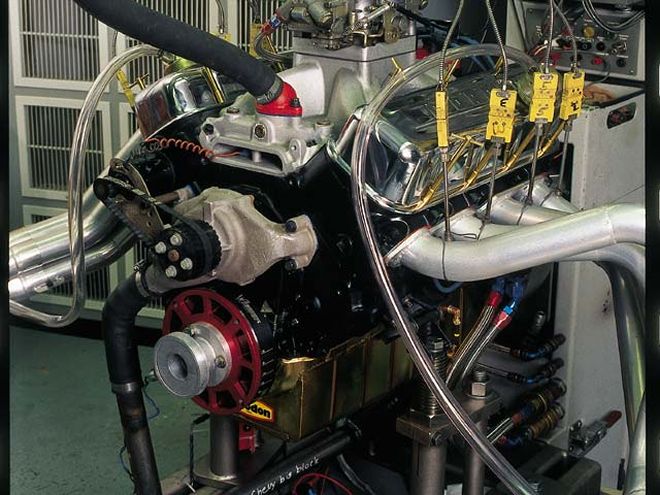
LDA
Lobe displacement angle (LDA), also known as lobe separation angle, is the distance in crank degrees between the intake and exhaust lobe centerlines. Although the installer can advance or retard the lobe centerlines during the cam installation process, the LDA between the centerlines is ground into the cam at the time of manufacture and can't be altered. Given similar-duration cams, a narrow LDA tends to increase midrange torque and yields a faster-revving engine; wide LDAs result in broader powerbands and more peak power. A wider LDA improves idle quality and initial off-idle driveability, particularly with a street driven automatic trans. But race cars with trans brakes like a narrower torque band, so they benefit from a tight LDA that moves the torque and power peaks closer together.
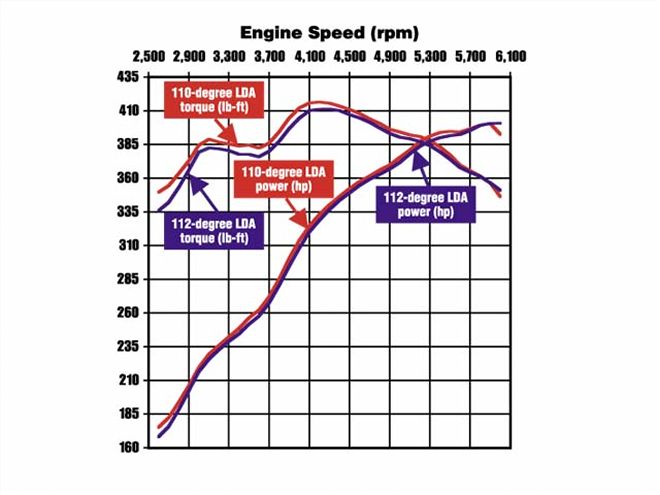 A Crane test of two similar cams ground with different LDAs shows that the tighter LDA made better power and torque through 5,500 rpm.
A Crane test of two similar cams ground with different LDAs shows that the tighter LDA made better power and torque through 5,500 rpm.
On a Crane Cams test of two similar hydraulic flat-tappet cams on a 355ci Chevy, a 110-degree-LDA cam outperformed the 112-degree grind through 5,500 rpm, even though the latter had slightly more lift and 0.050 duration. It was only on the extreme top end that the 112-degree cam pulled ahead. But as is typical with most popular engine dynos, we have no clue as to what happens under 2,500, nor can we measure part-throttle driveability.
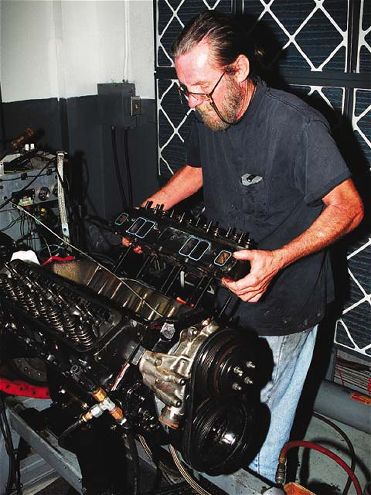 Crane maintains an extensive dyno facility to evaluate valve train and cam components.
Crane maintains an extensive dyno facility to evaluate valve train and cam components.
Not that low-end performance is great with either of these grinds. Both are marginally streetable at best in a 355ci small-block, but the narrower LDA cam would have worse idle quality and require even steeper rear gears and a higher stall converter than the 112-degree cam.
So which one's "right"? They both are--it just depends on the application. The worse the power/weight ratio, the wider the LDA needs to be. Stick cars can tolerate tighter LDAs than automatics. If you need to run power brakes, choose a wider LDA. A more efficient chamber can run a wider LDA and less ignition lead. Over 244 degrees at 0.050, the narrow LDA cam does offer better bottom end performance--but remember, the "bottom-end" on a cam like this is 3,500 rpm on a small-block!
 Flowmaster Mufflers maintains a dyno facility to evaluate exhaust products. One of its mules is this roller-cammed 9.0:1 502ci GM crate engine that runs on pump gas. It made over 100 hp more than one of those "same as, except" motors.Photo: Flowmaster Mufflers
Flowmaster Mufflers maintains a dyno facility to evaluate exhaust products. One of its mules is this roller-cammed 9.0:1 502ci GM crate engine that runs on pump gas. It made over 100 hp more than one of those "same as, except" motors.Photo: Flowmaster Mufflers
No Exceptions!
When an engine builder assembles a known combination, and a magazine reports on it, there's a reasonable expectation that an identically built engine should perform about the same. Read my lips: Identical does not mean similar. Identical means every critical part is exactly the same as the parts used in the buildup. All too often we hear, "I built an engine just like yours, except..." If you change anything, all bets are off. For example, even if a cam has the same gross catalog specs as a competitive cam, there's no guarantee it'll perform the same. Subtle variations in lobe shapes and opening and closing ramps can make a world of difference.
Equipped with a Crane mechanical roller cam (266/274 degrees at 0.050 on a 110-degree LDA), an Edelbrock Victor 4500 intake, and a Holley PN 2907 Dominator carb, a Flowmaster Mufflers development Chevy 502 made 675 hp and 600 lb-ft on pump gas through Flowmaster race mufflers. A local machine-shop built a similar engine for a customer, then rented time on the Flowmaster dyno to check it out. Oops, there's that word again: "similar." The ersatz copy had a 950-cfm Holley HP 4150-series carb, a Dart intake, and a virtually identical cam from another manufacturer. After run in, it made 560 hp. The manifold and carb were obvious deviations, so Flowmaster's intake and carb combo were bolted on. Now the engine made 600 hp. Finally, the customer borrowed Flowmaster's cam--and the engine made 670 hp. Unless you have a Cam Doctor, there's no telling why. Stick with proven parts.
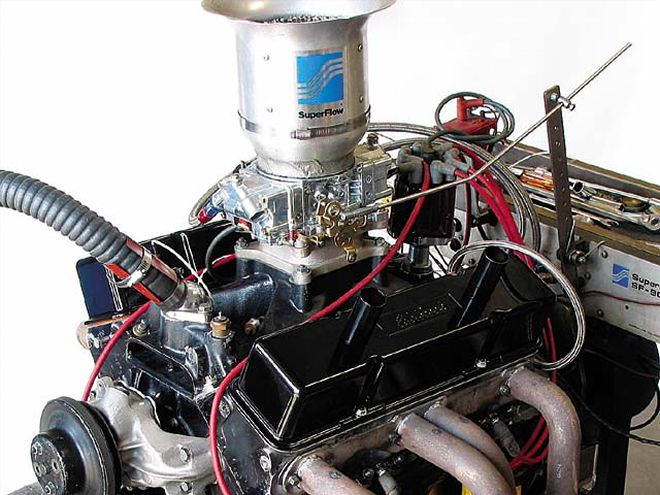 When Sherman put the right cam in the 421 stroker small-block Chevy, it gained 70 hp over the mismatched baseline combo.
When Sherman put the right cam in the 421 stroker small-block Chevy, it gained 70 hp over the mismatched baseline combo.
Cranking Compression Too High
A customer brought what was supposed to be a 700hp, 421ci small-block Chevy stroker racing engine in for testing on Joe Sherman Racing's Superflow dyno. It ran like a dog with 36 degrees total ignition lead, Sherman's usual Chevy Mouse-motor baseline starting point. Advancing the timing 2 degrees dropped power even more. Sherman next pulled the timing back in 2-degree increments, picking up 10-15 hp in each instance before the engine achieved its max output--only 620 hp--with just 29 degrees. That was way off a Chevy's normal timing window.
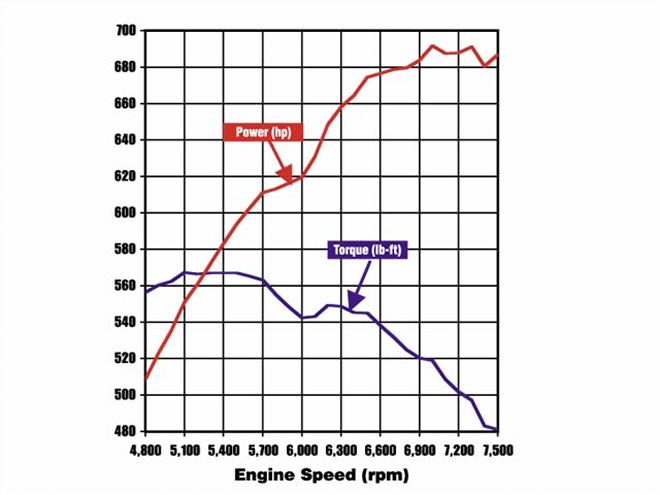 The larger Sherman-spec'd cam boosted the 421ci small-block Chevy's output to nearly 700 hp.
The larger Sherman-spec'd cam boosted the 421ci small-block Chevy's output to nearly 700 hp.
Sherman checked the cranking compression. It was 300 psi! The owner was unsure what cam he had, so Sherman tore into the engine. The cam had been installed 10 degrees advanced from split-centerline! But even rephased "straight up," Sherman knew from prior engine-building experience the 274/280-degrees (at 0.050) mechanical roller cam was too short for the application. Swapping in a slightly larger 282/290-degrees (at 0.050) roller installed 2 degrees advanced dropped the cranking compression down to 235 psi (about where it should be on a high-compression, race-gas-fueled engine). Now the engine liked 40 degrees of ignition lead, where it made 690 hp, a gain of 70 over the mangy cur Sherman originally received.
Moral: When basic engine tuning parameters fall way outside the norm for other engines of the same family, it's a sure sign that something's rotten, and not just in Denmark. You don't even need a dyno to check this--just a timing light, a compression gauge, and an e.t. slip!
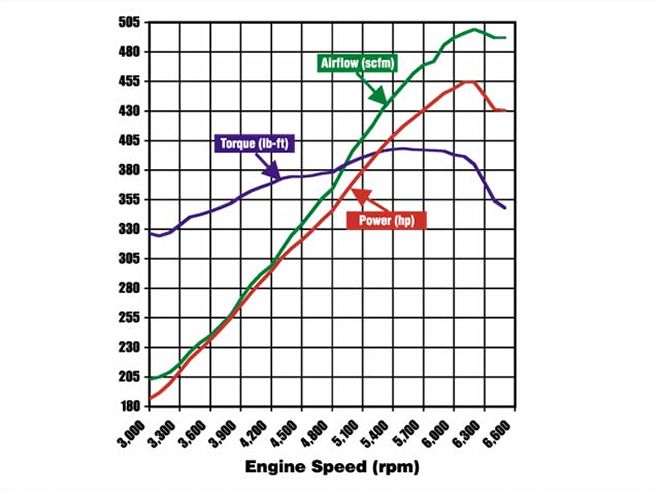 If cfm noses over on the top-end, the cause is usually valve float. Solutions may include stiffer springs, lighter valves and retainers, or moving to a mechanical cam.
If cfm noses over on the top-end, the cause is usually valve float. Solutions may include stiffer springs, lighter valves and retainers, or moving to a mechanical cam.
Valve Float
Normally, airflow (measured in cfm) increases along with engine rpm. But on a Westech Performance Group (of California) 302 Ford running a Comp Cams Xtreme Energy 282 hydraulic roller, airflow declined past 6,400 rpm. When cfm noses over along with horsepower on the top-end, it's a sign of valve-float. With the valves now hanging open, air flows back out of the cylinder head up into the intake tract, decreasing the amount of air sucked into the motor.
Early valve float is not unusual with hydraulic-roller cams, due to the weight of the tappets. Installing stiffer springs may cause the hydraulic lifter mechanism to bleed-down overnight, so the best solution for making serious power upstairs would be changing to a mechanical-roller cam.
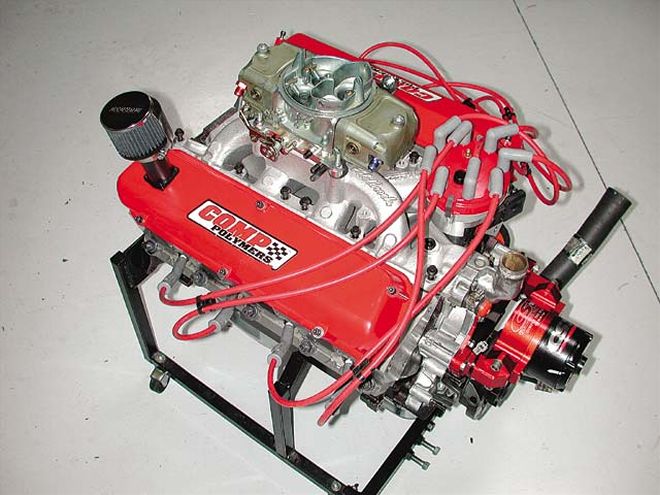 Equipped with an Edelbrock Performer RPM Air Gap intake, Demon carb, and free-flowing aluminum heads, this 302 Ford tested by Westech Performance was built to run upstairs--but its hydraulic roller cam popped out at 6,300.
Equipped with an Edelbrock Performer RPM Air Gap intake, Demon carb, and free-flowing aluminum heads, this 302 Ford tested by Westech Performance was built to run upstairs--but its hydraulic roller cam popped out at 6,300.
Cranking Compression Too Low
Westech Automotive (of Wisconsin) was asked to troubleshoot a '70 GTO's 400 Pontiac. Built by a local machine shop, it was meant to be a fairly hot, yet still driveable, street-performance engine. Unfortunately the mildly geared combo had no low end and barely idled with only 10-11 inches of vacuum, not enough for the power brakes. Adjusting the air/fuel mixture way rich was the only way the engine would start up and run in the morning. Limping into Westech, the car was using oil and smoking.
On a street-driven car running on pump gas, Westech wants the cranking compression values between 160 and 180 psi. Good tuners, or those with electronic timing controls, may be able to go up to 200 psi. But this engine cranked at just 135-150 degrees with its Comp 290H Magnum, even though it was factory-ground 4 degrees advanced. With the engine's 8.23:1 compression, this wasn't even in the ballpark.
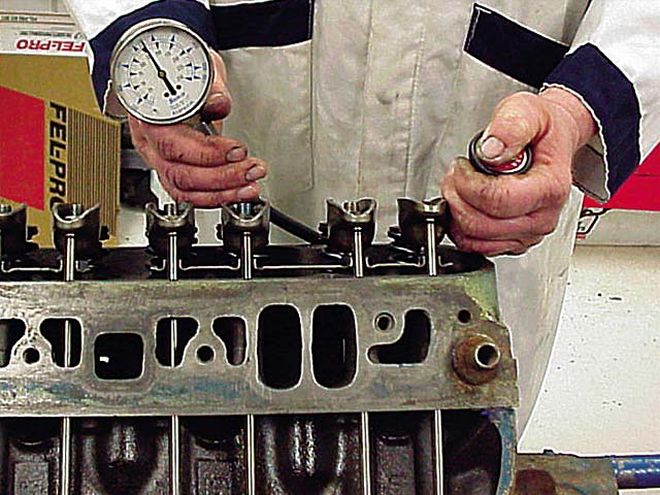 A simple compression check can tell you a lot about your camshaft selection. For street-driven engines on pump gas, shoot for 160-200-psi cranking compression.
A simple compression check can tell you a lot about your camshaft selection. For street-driven engines on pump gas, shoot for 160-200-psi cranking compression.
Advancing the cam another 4-6 degrees can help because it closes the intake valve earlier, trapping more pressure within the cylinders. Excessively high cranking compression--manifested on an octane limited car by excessively retarded timing or part-throttle detonation at peak torque--can be crutched by retarding the cam 4-6 degrees.
In this case, advancing the cam another 4 degrees barely put cranking compression into the lower end of the "acceptable" range, but the tired Indian was too far gone for any quick-fix. Low compression ratios don't build enough cylinder pressure (and heat) to generate a good flame kernel within the cylinder. This requires an over-rich mixture to vaporize the fuel--especially on cold Wisconsin winter days. With the engine losing seal from fuel-washed cylinder walls, a complete teardown and rehone was the best course, as it also permitted Westech to implement the ultimate solution: raising the compression to 9.5-10.0:1, and installing a quicker acting Comp Xtreme Energy XE268H or XE274H hydraulic flat-tappet cam.
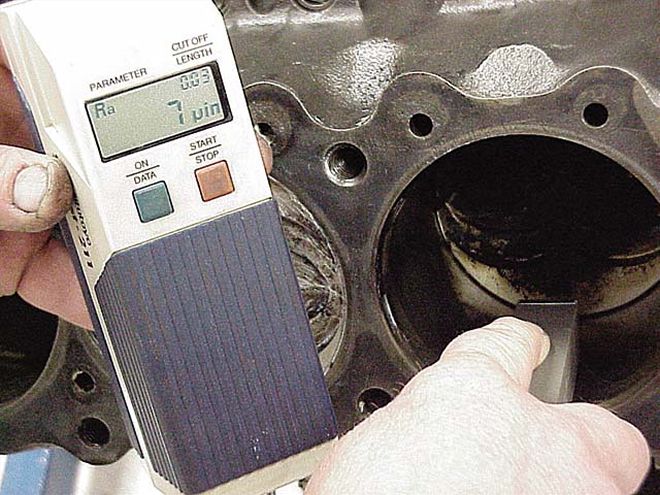 A profilometer shows the cylinder walls are "finished" (as in "kaput"). The rich mixtures needed to light the low-CR engine's air/fuel charge washed down the walls with liquid fuel, glazing them and ruining the ring seal. (That's why the car smoked.)
A profilometer shows the cylinder walls are "finished" (as in "kaput"). The rich mixtures needed to light the low-CR engine's air/fuel charge washed down the walls with liquid fuel, glazing them and ruining the ring seal. (That's why the car smoked.)
What if the short-block was still OK, and you wanted to scrape by with low compression? In that case, Westech would step all the way back to a cam with around 212 degrees 0.050-inch tappet-lift duration. Ugh--get out those new pistons!
Single or Dual-Pattern?
A good rule of thumb is that normally aspirated engines whose heads have exhaust-to-intake flow-ratios under 70 percent (i.e., the exhaust flow is 70 percent that of the intake) like a dual-pattern cam to crutch the weak exhaust port. Over 80 percent, you're in single-pattern territory. Blower, turbo, and nitrous motors generally prefer dual-pattern grinds because of the larger-than-normal exhaust volume they generate.
Then there's that 70-80-percent "gray" area in between. The only way to find out is to try both styles of cams, different ratio rockers, or (if the cam is mechanical) lash-loops. On a 9.25:1 383 small-block Chevy equipped with World Products Sportsman II heads, Ventura Motorsports' Ed Taylor tried both a Comp 268H High-Energy single-pattern cam and a Comp XE268H Xtreme-Energy dual-pattern grind. The XE represents more modern technology and has more aggressive lobes than the venerable 268H, but with the fairly good-flowing World Products heads, the 268H made more torque and power over 4,800 rpm on this engine.
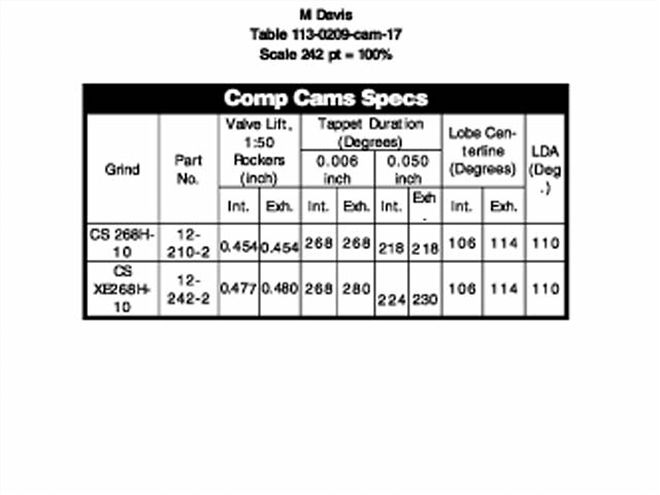
Remember, there's an exception for every rule; High-rpm mechanical-lifter race mills--even those with good flow ratios--may go down the track faster with a dual-pattern cam; they may not make more peak power than with a single-pattern, but SAM says they'll hold that peak longer.